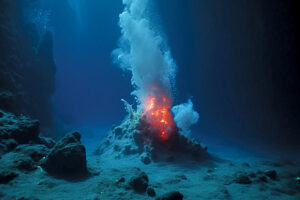
An undersea volcano, Axial Seamount, is expected to erupt in 2025, marking a significant advance in eruption forecasting. According to geophysicist William Chadwick, predicting eruptions more than a few hours in advance is rare. Located 470 kilometers off Oregon’s coast, more than a kilometer beneath the ocean surface, Axial Seamount shows signs of imminent activity, as reported by Chadwick and his team at the American Geophysical Union meeting in Washington, D.C. on December 10.
For the past decade, a range of devices has been closely monitoring Axial Seamount’s movements, such as rumbling, shaking, swelling, and tilting, transmitting real-time data through a seafloor cable. According to Mark Zumberge, a geophysicist at Scripps Institution of Oceanography, it is the “most well-instrumented submarine volcano on the planet.”
In November, a key development caught the attention of Chadwick: the surface of Axial had swelled to nearly the same height it reached before its 2015 eruption, shortly after monitoring began. This swelling is a sign that magma is building up beneath the surface, increasing pressure.
The 2015 swelling allowed Chadwick and his colleagues to predict that eruption, which he calls “our best forecasting success.” Now, the recent swelling, coupled with increased seismic activity suggesting moving magma, has led the team to focus on the next eruption. Additionally, a new tool developed by the research team allows for better predictions of the exact timing of the magma burst. Recent studies using artificial intelligence have also analyzed earthquake patterns preceding the 2015 eruption, helping to identify the signs to look for hours before the next eruption. “Will this precursory earthquake detection work?” Chadwick wonders.
If successful, this early detection could be a breakthrough for volcanologists like Rebecca Carey, who sees it as an exciting opportunity to use remotely operated vehicles to observe the eruption in real time. Carey, from the University of Tasmania in Australia, points out that witnessing an eruption firsthand would not only provide valuable insights into volcanology but also offer a chance to study its effects on nearby hydrothermal systems and biological communities.
While volcanoes on land typically pose greater risks to human populations than underwater ones, there are exceptions. The 2022 eruption of Hunga Tonga in the South Pacific, for instance, triggered a tsunami that caused an estimated $90 million in damages. Chadwick acknowledges that forecasting eruptions remains challenging. One of the concerns with land-based forecasting is the risk of false alarms, which could lead to unnecessary evacuations and erode public trust. However, he notes that at Axial Seamount, this isn’t a worry.
Accurate forecasting is made possible only through extensive monitoring and a deep understanding of how a specific volcano behaves. Valerio Acocella, a volcanologist at Roma Tre University in Rome, says there’s no “crystal ball” for volcano prediction, and forecasts are based on the idea that once a volcano’s activity reaches a certain threshold previously observed, it may erupt. Geophysicist Michael Poland from the U.S. Geological Survey agrees, adding that most forecasting today relies on recognizing patterns. However, there’s always a risk that a volcano may behave unexpectedly.
Both Poland and Acocella hope that future forecasting will be based on the physics and chemistry of magma systems. In the meantime, scientists will continue to learn from successes like Axial, which provides an ideal environment for testing predictions due to its frequent eruptions. Acocella considers Axial a promising volcano for this type of research, calling it an ideal case to better understand how volcanoes function.
Whatever occurs in 2025 may not revolutionize eruption forecasting, but as Acocella puts it, “we’ll gain a better understanding, which will also help us learn more about other volcanoes.”
